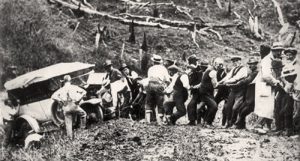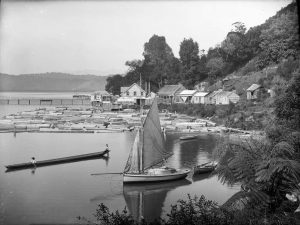 When travel around New Zealand was mostly by water, the harbour was the way that Kohukohu connected to the outside world. Timber was shipped out and manufactured goods shipped to us. The harbour walls built of Sydney sandstone ballast attest to the volume of this trade.
When travel around New Zealand was mostly by water, the harbour was the way that Kohukohu connected to the outside world. Timber was shipped out and manufactured goods shipped to us. The harbour walls built of Sydney sandstone ballast attest to the volume of this trade.
Looking at the photo to the left you can see how difficult travel by road was as late as 1917 where this group of politicians travel to the far north by motor vehicle!

Kohukohu 1893 showing a waka and a small yacht, and kauri in the booms behind.
As the forest retreated, dairy farming proved to be the way to go, given the high rainfall of the region and the limited size of many cleared farms. Herds were small, families did the milking. In 1907, a co-operative was formed to establish a dairy factory at Motukaraka, one of the assisted settlement areas. It was built on the harbour, with its own wharf, and its catchment area ran from Mitimiti to Waimamaku in the west to Otaua/Punakitere in the east, taking in all tributaries of the harbour in between. Waimamaku farmers, who had their cheese factory already operating, had to
choose - cheese or butter? Whole milk or cream only? Big cans or small? Local or distant? Cream was collected by launch wherever possible, being sledged or drayed from land bases. Collection was of necessity governed by tide-times, and launch drivers were skilled in navigating into and up the correct tributaries at any time of the day or night. The launches - named appropriately the Dairy Maid, the Butterfly etc. - were built to accommodate maximum cream-cans, full or empty: empties being dropped off as full cans were taken on.
Photograph for the sign from the Alexander Turnbull Library, Wellington, New Zealand (https://natlib.govt.nz/records/23188319)

